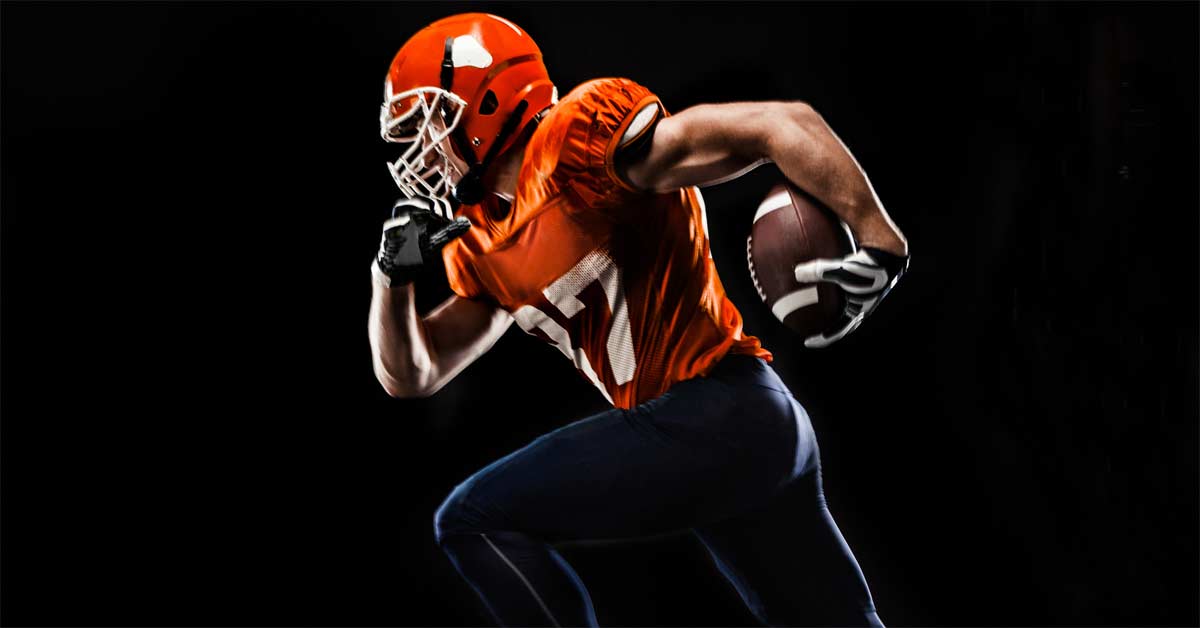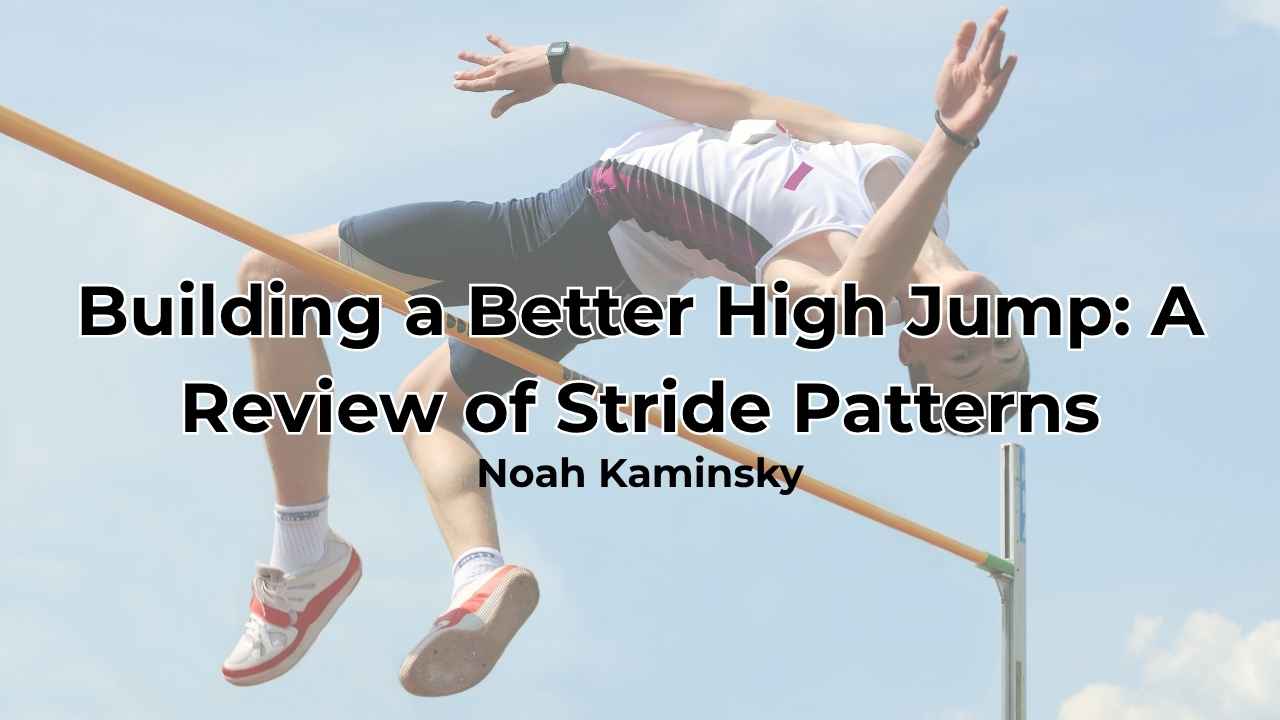One thing all athletic development professionals can agree on is we want our athletes to get the highest-quality adaptation possible to whatever training stimulus we program for them to do day in and day out. The largest obstacle to that is the individual readiness of each athlete and how much it can vary from day to day based on factors out of our control. We must also look at team data to understand the big fatigue/readiness picture.
Doing our part to ensure our athletes are able to maximize performance and mitigate injury is a very important job. While intuition and observation can often give us insights into how an athlete’s performance may be affected by such influences as sleep quality, nutrition quality, and other lifestyle factors, its accuracy can be low. Often an athlete may look fatigued and perform well, or the opposite. The more insight we can gain into the true readiness of each athlete, the more ability we have to provide an optimal effective dose in our performance programming.
The reality is if you have the budget, you can invest in a very expensive athlete monitoring system (AMS). However, most of us don’t have the resources for many top-of-the-line AMS options. So, should we give up on providing our athletes with this advantage? Speaking from experience, I say absolutely not.
Regardless of your budget or technological prowess, using an AMS in your program is within your grasp, says @YorkStrength17. Share on XI’ve used some sort of AMS for almost 10 years. During that time, it has evolved from a free, homemade version of a wellness questionnaire combined with some simple bar charts in our weight room to a multi-pronged approach featuring a complete sports science suite that includes not only a wellness survey with a body chart but daily use of a Just Jump mat and GPS. Regardless of your budget or technological prowess, using an AMS in your program is within your grasp. Adding the title of “fatigue manager” to your job responsibilities can be critical to making sure your athletes have a chance to thrive. If you have the willingness to pay the price in time, you can achieve this goal regardless of budget.
My First Experience: No Budget, No Problem
I first stumbled upon the idea of subjective monitoring of our athletes at a coaching clinic at AC Flora High School in Columbia, South Carolina. To be honest, I’d never really thought about the concept. I programmed a session for our athletes and expected them to perform. If I noticed an athlete was not feeling well or underperforming, it typically led to a conversation. Occasionally, this would result in an athlete stopping their workout and sitting out. Most of the time I made sure they pushed through.
The problem was the extent of my “if-then” questions. If they looked like they were struggling, then either they quit the workout or survived it. Neither of those choices are viable options when seeking to maximize performance.
My first look at an AMS was during a presentation in which a coach showed us a wellness survey they used that was within an expensive sports science platform. I immediately recognized that this could be a powerful tool in our program’s toolbox. The major roadblock was budget. At that moment, even a base package cost well over $1,000. There was just no way we could swing that cost.
However, a conversation with another coach at that very clinic provided me with the solution. I was introduced to Google Forms. This was a way to create a homemade survey with questions that I designed. We could weigh the answers to reflect the particular aspects of the questionnaire we felt carried the most importance (sleep and nutrition questions have a higher numerical value toward overall readiness than mood, for example). We also had the ability to mass email it to our student-athletes.
When completed, we could compile the answers in Google Sheets (similar to Excel) to give us a readiness score. Below is an example of how the original readiness survey and the team response looked. It had a total of 10 questions. We dumped the individual responses into Sheets, and I received a report that looked like this.

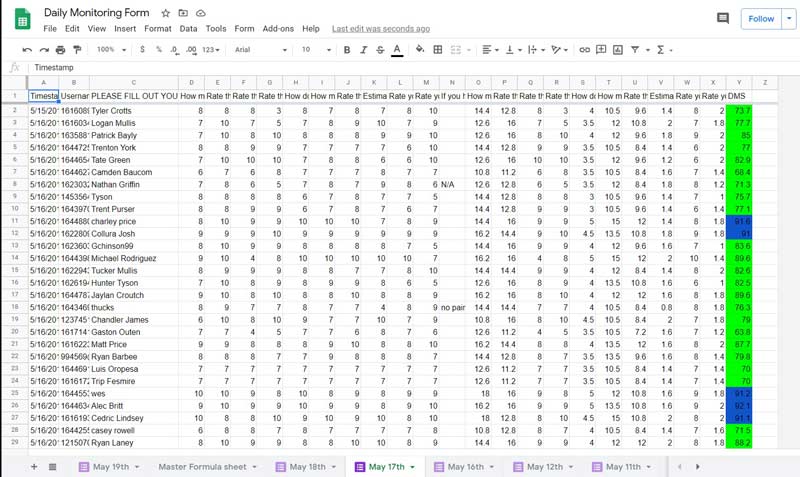
I also decided to add a special focus on hydration and sleep. I set up two bar-graph leaderboards in the weight room. When the athletes entered the room, the first thing they did was fill in a box on the graph next to their name if they got 8+ hours of sleep and drank 8+ glasses of water in the previous 24 hours. We used it as a type of wellness leaderboard. This not only gave the athlete a second level of accountability, but it also tapped into their competitiveness.
We used this system for just over a year. It worked well, and if faced with a budgetary shortage ever again, I would not hesitate to use it again.
Better Budget, Better Tech
As time went on, and we began to rely more and more on the data we collected to drive decision-making, the desire to improve our abilities to collect and store information drove us to look at a Web-based AMS. I reached out to the coaches I had originally heard presenting on the topic, and they directed me to a company that fit my needs. I was pleased to find that the price point was closer to the budgetary realities I was working within.
The product we chose to go with provided us with an editable wellness survey that could be sent directly to the athlete on a daily basis via a text message. I was responsible for sending the group text each day through an app on my phone. The program enabled us to produce reports and keep historical data that improved our record-keeping abilities.
However, what we were getting for the money was not that much of an upgrade from a cost-efficiency standpoint. We stuck with this platform for two years. While we continued to monitor and adjust, I still was not completely satisfied with our overall program of athlete monitoring. We needed more than a survey to help us drive important individual daily decisions.
Dialing In Our Process: Overview
In November 2017, I began my tenure in my current position at York Comprehensive High School. While it was an established sports performance program (I was the second full-time strength and conditioning coordinator at the school), the process of installing my program took precedence the first year or so. During that time, I actually stopped using any formal AMS.
After the first year, it was time to begin to work it back in. We began at the beginning, with the wellness survey. For a short time, we used Google Forms again. Shortly after that, the online strength and conditioning software we used at the time added the option of a survey. In December 2019, I switched our sports performance platform to CoachMePlus. I could go into the reasons for the switch, but this is not that article.
The AMS aspect of CoachMePlus is absolutely outstanding and takes the wellness survey to a new level with the addition of body charts, says @YorkStrength17. Share on XCMP provided us with a sports science platform to go along with a workout distribution feature that fit our needs. The AMS aspect of CMP is absolutely outstanding and takes the wellness survey to a new level with the addition of body charts. Not only can we get a subjective survey, but now our athletes can alert us to soreness and injury with a numerical level of severity through a click of the mouse.
I am aware of any soreness or potential injury issues before our athletes walk into our room. This is obviously a huge advantage in the decision-making process for each individual athlete. We are also able to monitor multi-day patterns that can lead to conversations with our sports medicine staff early in the process. If we can pre-empt just one injury to one athlete, this is worth the effort.
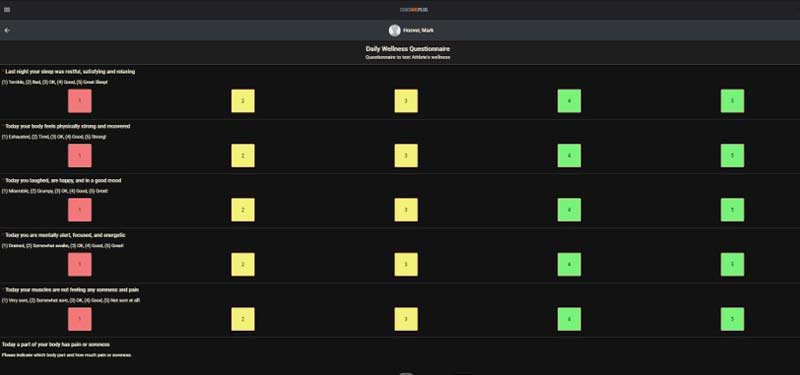
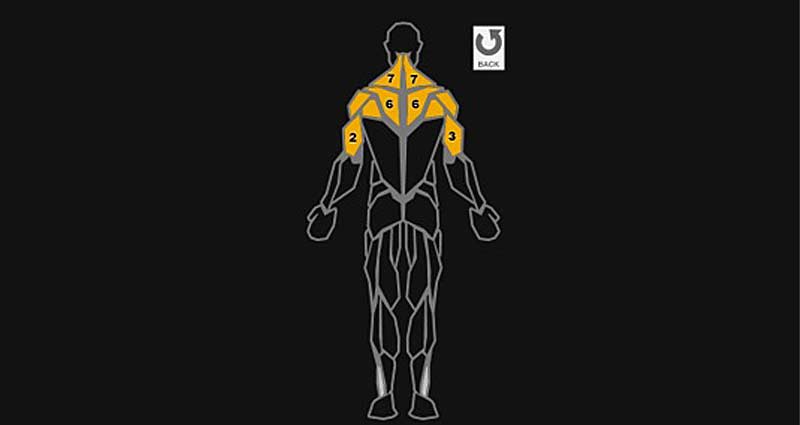
The “if-then” scenario of a low or high score on the readiness survey or indication of soreness and/or injury on the body chart all begin with a coach-athlete conversation. Empowering the athlete to be part of the decision-making process is a step that can help foster trust and build a relationship with the coach and athlete that will help both to flourish. It will also often clear up any concerns.
At times, this will lead to modifications that will ensure the athlete gets what they NEED that day and not just what the coaches want. More importantly, it can alert the coaching staff to any potential injury situation that could be worsened without this knowledge. The readiness survey and body chart can be seen as a subjective pre-screening that gives us more information to make sound decisions.
While subjective data is helpful to the process, I knew I needed some way to also collect objective data to best drive the decision-making process. We have one piece of technology at YCHS that I had never had before, and it became our test of choice. This was the Just Jump mat. The mat allows us to vertical jump test a large group of athletes in a very short time.
We began with a weekly test but soon expanded to a daily, cold vertical jump. I keep a very simple spreadsheet where I record each day’s cold vertical taken from each athlete as we walk into the facility. They do no warm-up or preparation for this jump. If we happen to have done any type of activity before we jump, I will not collect data that day for that group. My thought process is that this will give us a less variable-driven score.
This is much like weighing yourself when you first rise in the morning before you eat or drink any water. I’m looking for the truest baseline score I can get each day. In the score sheet we keep an average of all jumps in a given period or training cycle. We also keep track of the best jump of the cycle. Each of those data points plays a role in any potential programming adjustment that we may make.
While monitoring team averages and trends is important, the most important aspect of any AMS is the individual athlete and the process of maximizing individual performance. The other aspect of the individual is they are part of the team. If enough of our individuals are not recovering, that will lead us to a team solution. On the other hand, optimal dosage is our goal. If a majority of individual athletes show a high level of performance, it indicates that we can increase the intensity and shoot for a higher level of training on that day.
While monitoring team averages and trends is important, the most important aspect of any AMS is the individual athlete and the process of maximizing individual performance, says @YorkStrength17. Share on XFrom an individual athlete perspective, we use one major KPI as our driving data. The initial KPI that our athletes take part in, which I mentioned above, is our cold countermovement vertical jump using our Just Jump mat. Individually, we look for outlying results that may indicate the athlete’s ability to perform at peak power output for the day.
Before the athlete jumps, we already know from their readiness survey how they think they feel that day. We use the jump to confirm that subjective data using a rolling average of all jumps during the training period. Often, we have a low readiness score followed up by a conversation that gets us thinking we potentially need to adjust the athlete’s program. Then the athlete jumps and hits above their average or even a new personal record, which will most often lead to no adjustment.
Most athletes on most days fall within the range we look for on the jump. On any given day, we may have a small handful who don’t. We repeat the jump to confirm. This is an example of how we keep this data.
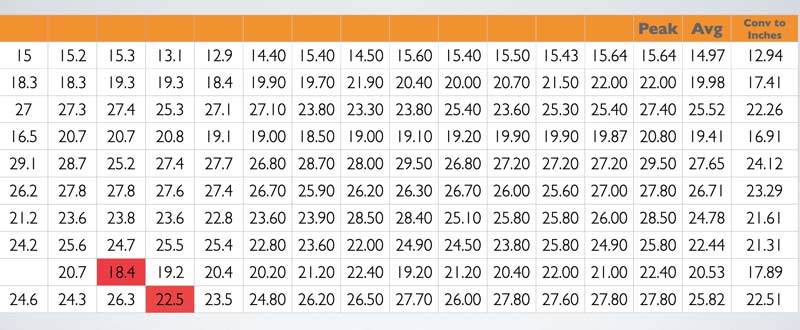
Two jumps below 90% of their rolling average will result in further investigation and often a modified program for the day. As mentioned above, we also occasionally have an athlete with a great readiness score followed by a jump 100% plus of their average. This can also lead to a modification, with a slightly increased intensity level.
Coaches familiar with APRE will recognize this protocol. We are an APRE program, and this particular process is driven by that philosophy. Below is the chart we use as a guide for modification. Conversation in this instance means a brief chat with the athlete to gauge their feeling of readiness and what they would individually feel they need that day.
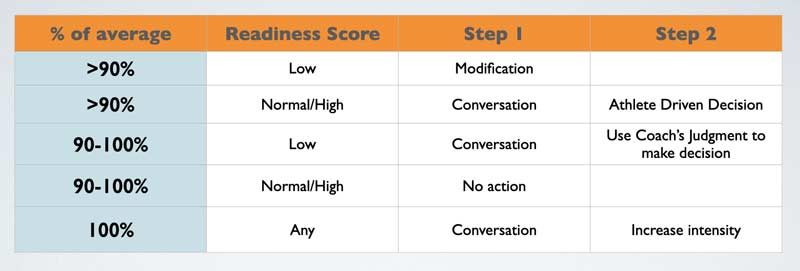

It’s important to note that this entire process usually takes less than five minutes. It’s imperative that you have daily modifications prepared in advance. Often, it’s as simple as lowering the intensity of the movement or the assigned load for the day. In some cases where we feel the athlete is unprepared from a fatigue or CNS perspective, we assign the individual an alternate program inside of the CoachMePlus system, which we can do from any device in seconds. Here is an example:
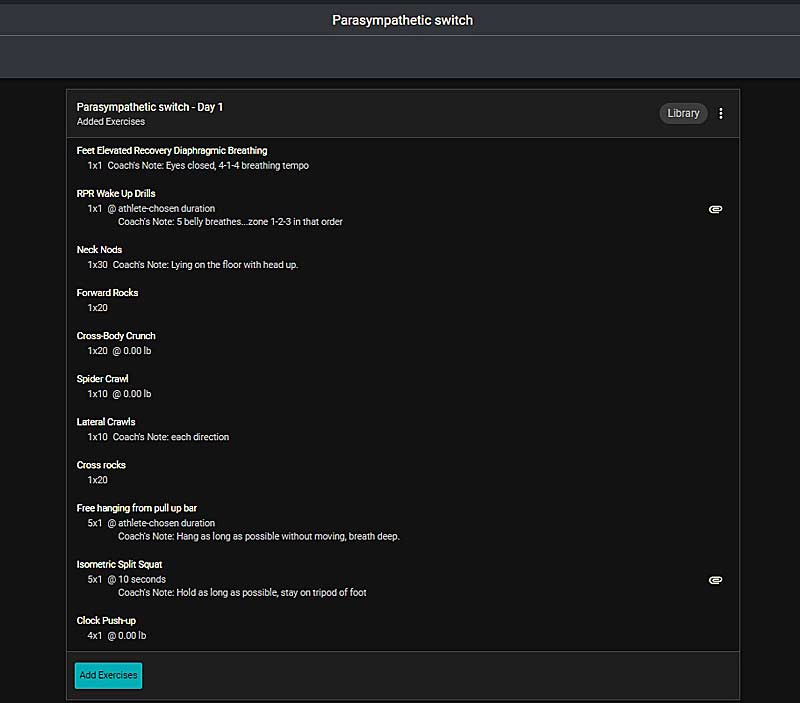
Our focus with these athletes is recovery. As much as we would like to utilize every minute to push strength and power adaptations, the reality is the goal is performance in the sport. To drive a fatigued athlete further into fatigue would be putting that goal in jeopardy. If both our subjective and objective data suggest the athlete needs a recovery session to maximize on-field performance, that is the direction we will go.
GPS
The latest tool in our toolbox is GPS. GPS allows us to do a deep dive into what level of stress our athletes are experiencing within their sports practice. The units give us the ability to track sprint volume, effort, and speed zones (among other things). Before we get any farther into the process, I must give any coach thinking about adding GPS to their program one word of advice. Make sure your sport coaches are on board and willing to develop a plan and stick with it.
Part of the challenge for most North American strength and conditioning coaches (particularly at the high school level) is that while we can most often control the volume and intensity, etc. in our weight rooms or our speed programs, once the athlete is at practice, we are at the mercy of the sports coaches. Unless you work with coaches who will adjust what they want to do based on what the data may say needs to be done, I’d suggest investing in other areas besides GPS. That being said, if you have coaches with a growth mindset and a willingness to work within the data, GPS can be a very powerful tool.
If you have coaches with a growth mindset and a willingness to work within the data, GPS can be a very powerful tool, says @YorkStrength17. Share on XA second word of advice is to select a small number of data categories that will give you the best possible picture and stay focused. Too much data can become noisy fast and lead to frustration. The last thing you want is the coaches you work with to not have the time or the willingness to sift through long reports. Be precise and stick to the data that gives a clear picture of what is important to the sport.
I selected our categories to track based on a series of conversations with a high school coach who has been using GPS and my education in the process of using our units. We narrowed it to 11 categories to draw from on a daily basis. However, we draw our main monitoring data from an individual session score (a comparison of work done as compared to other players), sprint volume in yards (which was a combination of two other categories: zones of 80-89% and 90+% of previous max velocity), and top speed in mph. In addition to individual athlete data, we also keep a team average for each. This allows us to not only get an individual picture for each athlete but also one of the team overall.
Team Data: A High-Performance Practice Plan
Our football program is currently the one that utilizes our GPS units most effectively. Our head football coach is actually the reason we have GPS units, as he wrote a grant for our first four units. He is highly invested in the process, and that has led to our ability to use the GPS and all aspects of our overall AMS to develop a practice plan that’s designed to have our athletes in position to perform at their highest level on game nights. We call this our high-performance practice plan. This plan is built and monitored entirely on the team averages for each category. While there are many ways of practicing, we decided to go with the plan seen in figure 7.

On Monday, our goal is to have our highest volume and workload of the week. Traditionally, Monday is not always that type of day in high school football. We must remember that this is not necessarily tied into the sports-specific aspects of practice. It just means we want the highest volume of 80%+ sprinting for the week on this day.
Our session score, which is a comparative workload, is the second factor, and it is actually in contrast to our sprint volume. So, while we want the highest volume of sprints, we also want to see the lowest average session score. This lends itself to a slower learning pace at practice with our sprints coming from drills or post practice speed work. If you have the luxury of having the athletes in class during the day (as we do), you can also utilize that time to get some high-quality sprinting to ensure you get to your goals for the day.
Tuesday for our team is a higher intensity day from a physical contact perspective. We want to make sure that this is the day we have the lowest high-speed volume. Our goal is to keep our athletes in position to be as fully recovered as possible each day. To help that process, we keep our heaviest contact day our lowest sprint volume day.
Wednesday is a combo day. Contact is not as heavy as on Tuesday, allowing for the recovery process to begin for Friday. Sprint volume will not be as high as Monday because we have recovered more from less work done on Tuesday.
Thursday is low and low. We want to see high top velocity and acceleration data, but overall volume should be at its lowest point of the week.
Figure 8 shows an example of the data I select and download from our GPS pods for a day of practice.

We use GPS particularly with our football athletes as a lagging key performance indicator (KPI). What I mean by this is we do not monitor our GPS in real time. Instead, we collect this data and reviewed it the next morning.
The main purpose of our GPS data collection is to drive the High-Performance Practice Plan from a team perspective. This, however, does not mean we don’t also look at individual data. We monitor our individual sprint volume and session scores, looking for consecutive days of greater-than-average numbers.
We also monitor the athletes’ max velocity. We want our skill athletes to hit 90%+ of max velocity at least twice a week in practice. Our belief is that if we look at our athletes as high-performance race cars, we don’t want their first dosages of max velocity to be on race day. We believed in this philosophy even before we had GPS capabilities. Prior to GPS, we took one day a week and ran 2-4 full-speed 40- to 60-yard sprints in our athletic development class. GPS allows us to see if they hit that speed in practice, and we only sprint in class now if the data indicates the need.
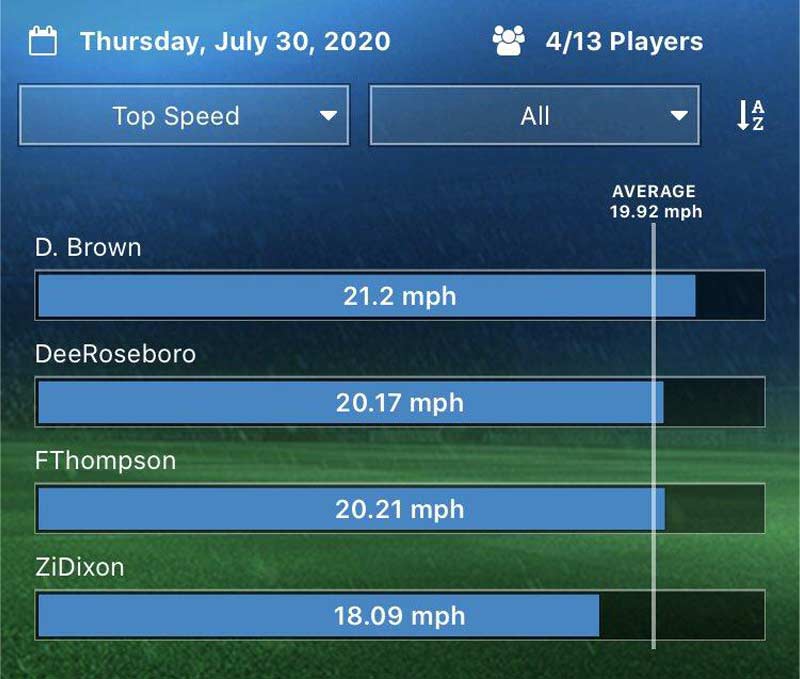

From a team GPS perspective, it’s fairly simple. I give our head coach a daily report IF there is an outlying issue. This could be too much or too little volume or session score based on the plan. This could also be because of the lack of max velocity over 90% by our skilled athletes. In this instance, that is where my scope of influence ends.
The sport coaches make the adjustments based on my recommendations. Normally, they do this by modifying post-practice speed work or building in modifications to the individual sessions of practice. If an individual athlete needs modifications, the position coaches, again, handle this. As you can imagine (and as I mentioned earlier), this is 100% sport coach cooperation driven. If you don’t have a staff that has this type of growth mindset, you will become frustrated quickly.
The Best Ability Is Availability
I can sum up the driving force behind my desire to include a fatigue management program with our athletes in one clichéd phrase: “The best ability is availability.” I mean this not just for having a program in which your athletes are able to dress and participate in games and practices. My goal is for our athletes to thrive in those situations.
Using a multilevel AMS that gives us insight into both individual and team readiness allows us to put our athletes in position to be the best version of themselves while playing their sport. Share on XUsing a multilevel athlete monitoring system that gives us insight into both individual and team readiness allows us to put our athletes in position to be the best version of themselves while playing their sport. Whatever your budget is, as long as the desire to monitor your athletes is present, there is a way to do it.
Since you’re here…
…we have a small favor to ask. More people are reading SimpliFaster than ever, and each week we bring you compelling content from coaches, sport scientists, and physiotherapists who are devoted to building better athletes. Please take a moment to share the articles on social media, engage the authors with questions and comments below, and link to articles when appropriate if you have a blog or participate on forums of related topics. — SF

